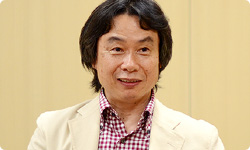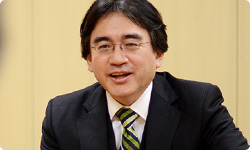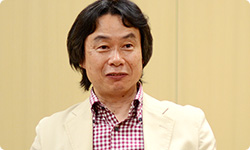1. Ganon’s Castle as the Only Setting?
(sitting down) Am I the only one today?
Yes, today it’s just you.
Oh. I have no idea what everyone else said, though.
You’re busy preparing for E31, so you couldn’t find time to participate together. As we go along, I will tell you what the original developers said in your absence. Thank you for coming. 1E3 (Electronic Entertainment Expo): A video game trade show usually held once a year in Los Angeles. In 2011, E3 was held for three days starting June 7.
No problem.

Today I’d like to look back with you at The Legend of Zelda: Ocarina of Time. The development period for it was far longer than for other games at the time and the release date got pushed back more than once.
The original plan was to release Super Mario 642 simultaneously with the Nintendo 64 system and to bring out The Legend of Zelda: Ocarina of Time3 the following year for Christmas. 2Super Mario 64: The first 3D action game in the Super Mario Bros. series. Released simultaneously with the Nintendo 64 system in Japan in June 1996. 3The Legend of Zelda: Ocarina of Time: An action-adventure game released for the Nintendo 64 system in Japan in November 1998.
It was scheduled to go on sale at the end of 1997.
Yes. So it was almost one year late.
Development took about two and a half years. It must have been terribly hard on the developers, but they all said it was fun!
Oh, they said that?
Yes. They even said “Fantastic!” when the release was delayed! (laughs)
Really? (laughs)
Everyone talked about it so happily that I wondered if over the last 13 years they’ve simply forgotten all the hardship. (laughs)
(laughs)
How was it for you?
It wasn’t hard for me either. Developers generally like it when the deadline gets pushed back anyway.
Everyone did say, “Now we can polish that up!” and “Now we can fix that one spot better!” when we got the extension.
Right. Up until the very end, we were saying, “This needs more work and that needs more work.”
I hate to say it, but if the development period goes on an extra year, it can’t all be fun.
You’re right about that! (laughs)
But everyone says it was fun.
Yeah. Well, maybe it’s like asking, “Are you happy when the date of a test gets put off one week?”
Ah, I see. (laughs) Because when it comes to studying for a test, you can never study enough.
That’s right. You may think, “I’m happy I can study more,” or you may think, “Now I have to study next week.” But if you’ve got the energy to keep studying hard, you’re happy the exam got pushed back. (laughs)
How did you view the project when that long development spanning two and a half years began? Everyone was just plunging ahead into unknown territory, right?

That’s right. Back then, no one knew which direction the overall game industry was heading.
That’s true now too. (laughs)
I suppose so. (laughs) But back then, for example, if you had a big three-billion-yen project, no one knew if it would end up costing five billion, or two billion.
Yes, you couldn’t see ahead back then. I wonder how we ever managed! (laughs)
No kidding! (laughs) The only person who knew was the person who budgeted the scheduled projects. But that person can’t guarantee anything when it comes to how fun the game is.
Uh-huh.
And Ocarina of Time was one of the very first of such games, I mean, it was a huge project of making a game in 3D polygons without knowing the final outcome from the beginning.
It was bigger in scale than anything you had previously experienced.
I did, though, have experience building up games one by one.
You had made game after game since even before the Famicom system.
And aside from me, (Toshio) Iwawaki-san and (Kazuaki) Morita-san at SRD4 had built up programming experience making 3D graphics for Super Mario 64 and other games. And I think (Yoshiaki) Koizumi-san and those guys had a rough idea of how they wanted to make The Legend of Zelda in 3D based on their experience developing Super Mario 64. 4SRD Co., Ltd.: A company established in 1979 that contracts to develop video game software programs and develops and sells Computer Aided Design packages. The head office is in Osaka, and their Kyoto office is inside the Nintendo head office.
Yes, that’s right.
But no one knew how big in scale it would become.
Even you didn’t know how big it would be, but began working on it.
Yes. And I’m not talking about budget or development period issues, as we just touched on, but because the memory size we could use with the Nintendo 64 system was fixed, I couldn’t tell how vast a game could be developed within that capacity.
Back then, the limits of the hardware weren’t that high, so you could only do so much.
Right. So rather than start by determining a story, we started by making the system.
That’s how you always do things. I remember you saying you couldn’t make a Zelda game until you had become familiar with the new hardware.
Yes, I said that. I had already made Super Mario 64 and Star Fox 645 for the Nintendo 64 system, so I had built up a certain degree of know-how. 5Star Fox 64: A 3D shooting game released for the Nintendo 64 system in Japan in April 1997. Released in Europe under the name Lylat Wars.
Like the proprietary camera system and real-time movies.
Right. And we had to make something big, but with limited memory. So, for example, suppose certain data were structured into an “ABC” set, “ACD” set and “ADF” set. When each set exists independently, you can read them all at once, but...
With each of them independent, they take up a lot of memory space.
Right. So I would have “A” stay there all the time and the other data switch in and out. If you only change what you have to, the memory is more efficient and the data is read more quickly. In other words, you make good use of the characteristics of the ROM. We put constructing the system first, and since we were going to determine the story in line with the system’s capacity, at first I thought only having Ganon’s Castle might be enough.

Huh? At first you imagined Ganon’s Castle as the only setting?
Yes. I thought about putting all kinds of adventures into the different rooms, like making a dark meadow or an ocean - like in Princess Peach’s Castle in Super Mario 64.
You imagined lots of rooms in Ganon’s Castle, with various worlds all connected.
Yes. In the worst case, Link wouldn’t have been able to go outside the castle! (laughs)